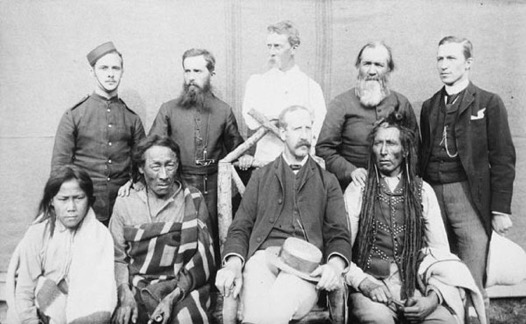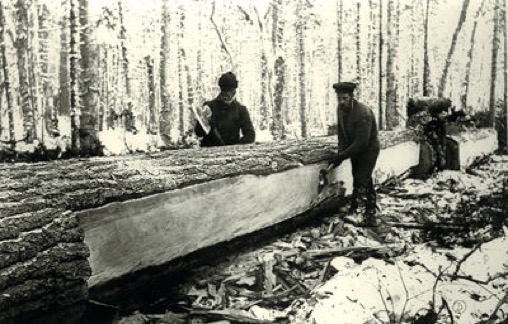Introduction
In 1867, Queen Victoria granted royal assent to the British North America Act. The Act united the Provinces of Canada, Nova Scotia, and New Brunswick into one Dominion under the name of Canada. This is known as Confederation. After Confederation, Canada had slightly more self-governing autonomy than it had before. Matters of land and natural resources were now provincial jurisdiction, and the Federal government was now responsible for “Indians and lands reserved for Indians”. So what would this new arrangement mean for our people? For Algonquins in the Ottawa River basin, the years after confederation were difficult. Loss of territory, loss of health, loss of identity, loss of autonomy - these were the hallmarks of Confederation that our people remember.
The Indian Act
By the later half of the 1800’s, various pieces of legislation identifying and relating to “Indians” were enacted.
An Act for the Better Protection of Indians in Upper Canada; An Act for the Better Protection of the Lands and Property of Indians in Lower Canada; the Gradual Civilization of the Indian Tribes of the Canadas Act; an Act for the Gradual Enfranchisement of Indians and the Better Management of Indian Affairs; the Management of Indian Lands and Property Act - in 1876 ... all of these statues were amalgamated to form The Indian Act.
From its inception, The Indian Act was amended numerous times, focusing more and more on intrusion, control, and assimilation, and less and less on protection and honouring the treaties. Legislative controls and/or prohibitions were placed on religious practices, voting, leadership selection, mobility off-reserve, trade and commerce, and the raising of funds for claims.
The Indian Act maintains conflicting and parallel objectives: the protection of Indians and their lands on the one hand, and the control, assimilation, and civilization of Indian peoples on the other. At the same time, by actively asserting itself as a protector or manager of Indian interests, the Crown has created trust and fiduciary responsibilities which it owes to the Indian nations and their citizens.
Today, we are still bound by the Indian Act in matters of Band politics and social status.
Timber Trade
If the Fur Trade had been our region’s economic mainstay throughout the 1600s and 1700s, by the late 1830s there was no doubt that Timber Trade was now king. The Canadian forest industry moved into our Lake Temiskaming region. The first timber shanties were established on Lake Temiscaming by the McConnell brothers from Hull. Giant pines were cut in the winter and floated in spring log drives down to Quebec where they were shipped to Britain. By the 1860s the importance of the sawed lumber trade had become equally important.
As areas down river were logged to the point of deforestation, prominent lumbermen like J.R. Booth and E.B. Eddy increasingly turned their attention to the upper Ottawa. As of 1885, there were over forty shanties employing over 2000 men in operation between the Long Sault rapids, Kipawa and Lac des Quinze. By 1900, these shanties employed 5000 men.
Locally, the largest sawmill was run by Alex Lumsden. Erected in 1888 near the head of the Long Sault, Lumsden was part of a company formed in 1883 that had embarked on a project to regulate water flows to facilitate log drives to Lake Temiskaming. Parts of Lake Kipawa were dammed, and four small lakes were joined together to create an artificial stream called Gordon Creek. The log houses of the river drivers and sawmill workers formed the nucleus of the present day town Temiscaming.
Entirely unregulated, these logging activities showed no consideration for the surrounding ecosystem, or the rights and interests of our people whom were permanent residents of the area. Blocked or diverted waterways destroyed critical fish and wildlife habitat. They altered the natural seasonal flood patterns on our lands. The impact was felt on both our habitat and its capacity to support fur bearing animals. And to make matters worse, the transient shanty men brought with them diseases like cholera, measles and tuberculosis. We were constantly under the threat of disease and dispossession.
Disease and Dispossession
After 1880, due largely to the urging of Oblate missionaries to stop the flood of rural Canadians leaving for the New england states, the Province of Quebec began opening our traditional Algonquin lands in the Temiscaming region to agricultural settlement. In 1884, the Oblates helped found the Lake Temiscamingue Colonization Society, and over the following decades, these agents of the church actively promoted agricultural settlement along the Quebec side of Lake Temiscamingue and up the Blanche River on the Ontario side.
Land prices were set deliberately low to attract settlers. Subsidies were provided for seed, implements, steamers and road building. By 1900, there were settled townships all along the lake. New villages such as Ville-Marie and Notre-Dame du Nord were followed by Guigues, Duhamel and Fabre.
After settlers began arriving in the mid-1880’s, pressure quickly mounted for a quicker means of travelling to Lake Temiscaming. At the time, the only access to the area was through a series of gruelling rapids, known as the Long Sault, which flowed form the present-day town of Temiscaming down to Mattawa. While the name of ‘Long Sault’ described the series of rapids, the portages themselves came to be known in English as, the ‘Moccasin Line’.
In 1886, the Lake Temiscamingue Colonization Society built a narrow-gauge railway throughout the Moccasin Line to accommodate freighting tramways. The new transportation system was formally called the Temiskaming Colonization Railroad. Would-be settlers and prospectors could now travel from Ottawa by train and transfer to lake steamers which would take them up to Baie des Peres (Ville-Marie) and the head of lake Temiscaming.
By 1891, the Canadian Pacific Railway purchased the Colonization Railroad. And for the next hundred years during a succession of extensions, modifications, and upgrades, the Moccasin Line remained a vibrant and viable carrier of goods and people. But, as the 20th century progressed, train transit began to decline as the primary means of access into the area. In 1987 the Canadian Pacific Railway lifted the rails north of Temiscaming, thereby eliminating access to the Temiscaming train station, and ending the line at the Tembec mill yard. Nine years later, the Ottawa Valley RaiLink assumed the daily responsibilities of moving products from the Tembec mill.
From 1998 to 2002, the Moccasin Line doubled as a tourist attraction. It was called the Timber Train. Tourists boarded the Timber Train in Mattawa, Ontario, and got off at the Tembec site in Temiscaming, Quebec, where they had the choice of a mill site tour or an Algonquin cultural tour. The tourist train is since defunct and today the Moccasin Line is reserved entirely as a conduit for shipping and receiving Tembec products.
In 1886, about half of the 400 people living around Lake Temiscaming were Algonquin. At that time White settlement and logging were steadily on the rise. Our hunting grounds and gathering sites were being replaced by farmland, and diseases were still a very serious threat. By 1901, we constituted less than 5% of the local population.
Some of us moved to the Reserve at the head of the Lake Temiscaming to escape the distress. But the majority of us, intent on preserving the traditional lifestyle, opted to retreat further into the bush around Lake Kipawa and Lac des Quinze, where we would remain for another generation.
Despite the displacement, we could not so easily escape the waves of smallpox scarlet fever, tuberculosis, and chicken pox. Our leaders regularly petitioned the federal and provincial governments for medical assistance - as did the missionaries and fur traders. The government of Quebec refused to provide any sort of aid. For its part, the federal government reasoned that it could neither safeguard our lands nor our future without the cooperation of the province.
To say the federal and provincial governments were unaware of our distress economic and health circumstance would be a lie. They knew full well that we were suffering. With regularity our leaders petitioned them, as did the missionaries and fur traders, for greater medical and material assistance. However, with the government of Quebec very hostile to any and all Algonquin land and resource claims it refused not only to recognize our inherent rights, but it refused to provide humanitarian aid when the need arose. For its part, the federal government used the excuse that it could not safeguard our lands and our future without the cooperation of the province. As such, we continued to be treated throughout the last half of the 19th century as squatters on our own lands. For most of Algonquins in the Ottawa River basin, the early years after Confederation has been a bust. What the 20th century would hold for the Anishnabeg who would live their lives under the bureaucratic thumb of Canada’s Department of Indian Affairs, well that is another story.





